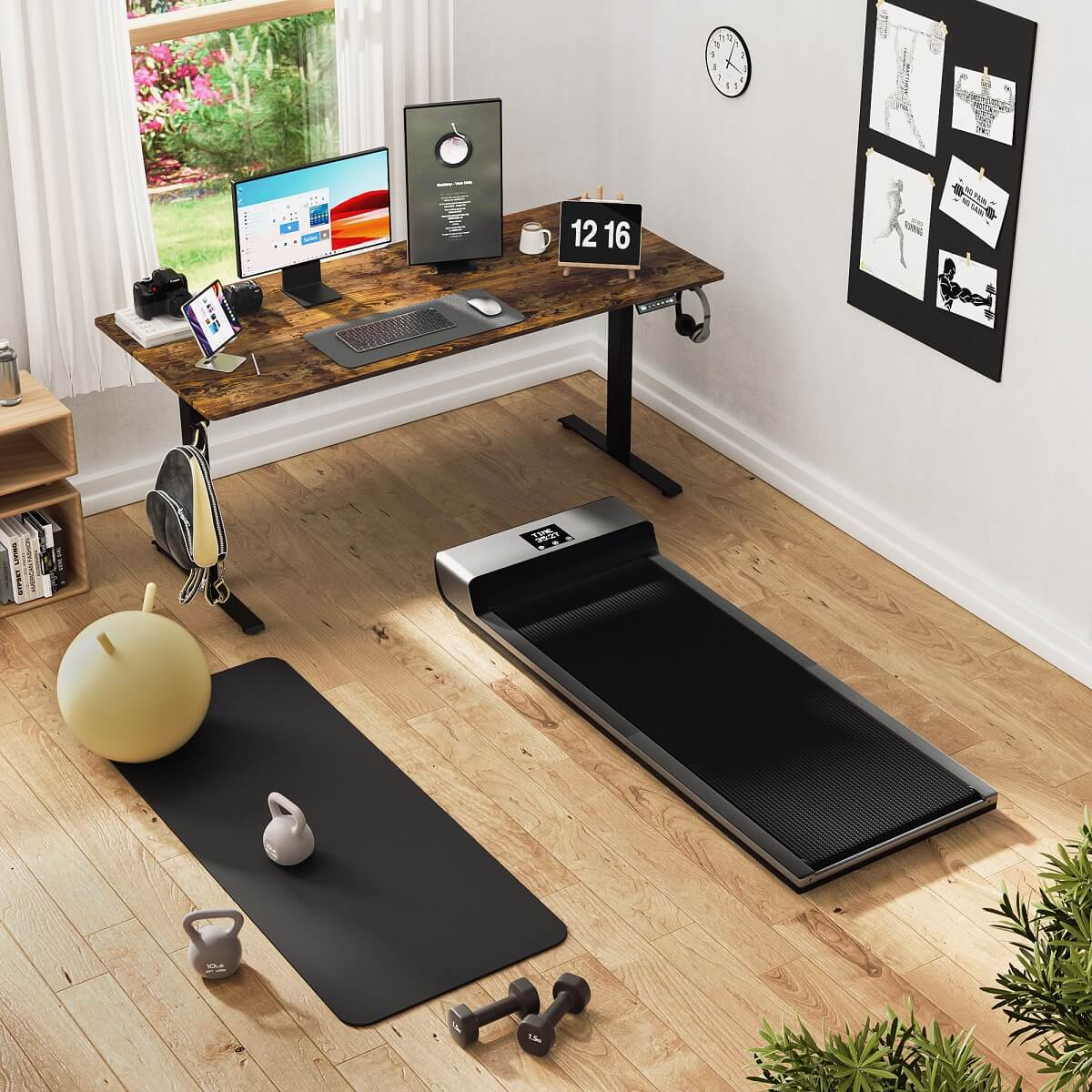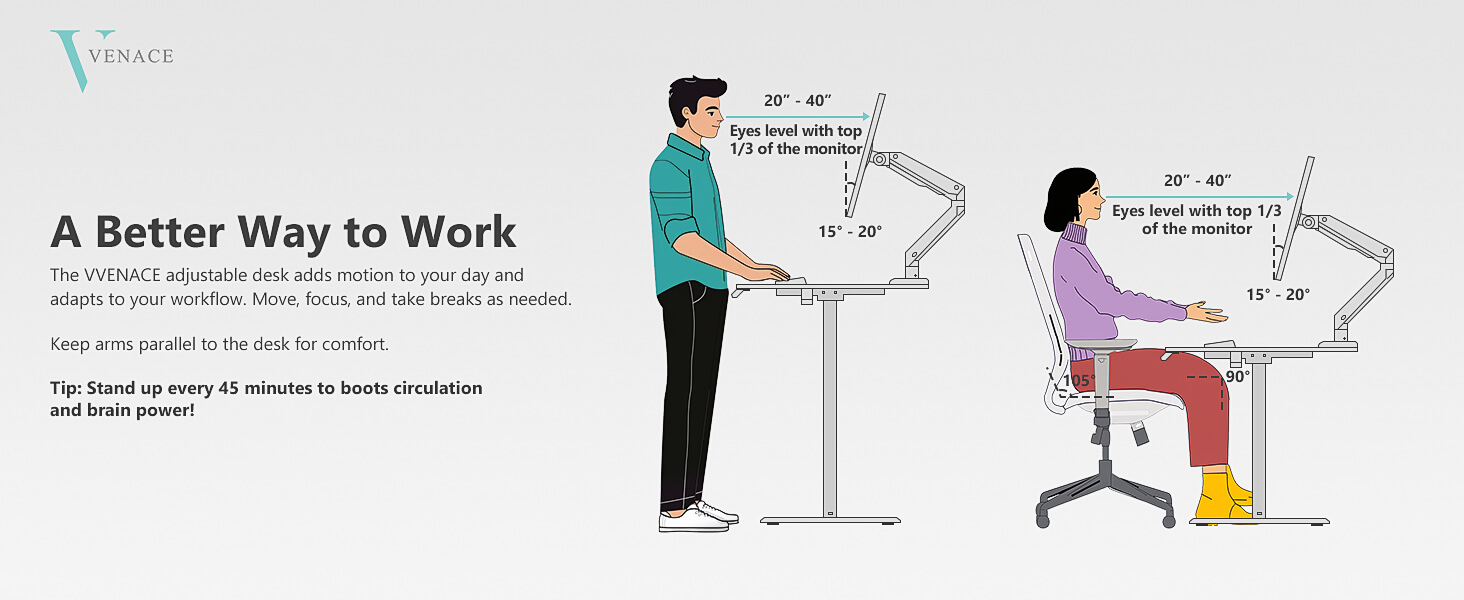The Impact of Ergonomic Desks on Workers with Chronic Pain
Chronic pain. It’s the unwelcome companion that millions of workers know all too well. It starts small—a twinge here, a tightness there—but over time, it grows. For many, the office isn’t just a place of work; it’s the place where pain begins. The long hours hunched over desks, the hours of sitting still, the poor posture—it all adds up, day after day. Back pain. Neck strain. Stiff joints. The list goes on. But here’s the twist: ergonomic desks—specifically, standing desks—are not just office furniture. They’re solutions. Transformative solutions.

Chronic Pain in the Workplace: A Silent Struggle
It’s easy to underestimate just how much chronic pain can affect your life until it becomes a constant presence. For millions of office workers, hours spent in front of computers lead to aches and pains that linger, even when the workday is over. The simple act of sitting—just sitting—can lead to long-term muscle tension, joint discomfort, and even exacerbate underlying conditions like arthritis or sciatica. And the toll isn’t just physical; pain can drain energy, reduce concentration, and cause frustration. For workers with chronic pain, the office becomes an arena where the body is in battle, and it’s a fight that’s hard to win.
You’ve heard the complaints before—stiff shoulders, sore necks, aching backs. These are symptoms many office workers experience on a daily basis, especially those who spend hours sitting. What most don’t realize is that the simple act of sitting in an office chair for hours on end is the culprit. It sounds harmless enough, but over time, poor posture, muscle imbalances, and lack of movement all combine to worsen the pain. This is where ergonomic desks step in, offering a potential solution for those struggling to manage their pain.
The Magic of Ergonomic Desks: Standing Desks for Pain Relief
The science behind standing desks isn’t as complex as you might think. They work by allowing you to shift your posture throughout the day—alternating between sitting and standing. This simple switch can reduce strain on the back, improve circulation, and support a more neutral, pain-free posture. In other words, a standing desk is your body’s chance to break free from the endless cycle of sitting and slouching.
But there’s more to it than just the ability to stand. Ergonomically designed desks, like standing desks, do more than simply let you stand. They actively encourage better posture. They help you avoid hunching over your keyboard, which is a posture that strains your neck and spine. By providing a more natural, upright stance, they help relieve the pressure on your spine, especially the lower back, which is where most chronic pain originates.

How Standing Desks Impact Chronic Pain
So how exactly do ergonomic desks make a difference? Let’s break it down.
-
Spinal Pressure Relief
Sitting for long stretches compresses the spine. This pressure, day after day, becomes cumulative. When you stand, that pressure is reduced. The spine elongates, which means less strain on the vertebrae and surrounding muscles. For those with chronic lower back pain, this simple act of standing can provide significant relief. -
Boosting Circulation
Sitting reduces blood flow to the legs, leading to swelling, stiffness, and discomfort. Standing, however, stimulates circulation and reduces the risk of blood pooling in the legs. Better circulation means less swelling, more energy, and fewer aches. And for people suffering from conditions like varicose veins or joint pain, this is a game changer. -
Breaking the Stagnation
We all know the feeling. Sitting for hours makes your muscles feel tight and sore. It’s the body’s way of saying, “Get up and move!” Standing desks help break that cycle. Alternating between sitting and standing ensures that the body doesn’t remain stagnant for too long. This gives the muscles a chance to stretch and recover, reducing tension and improving flexibility. -
Fighting Muscle Fatigue
When you sit for long periods, certain muscle groups—the ones in the back, neck, and hips—are under constant strain. But when you stand, you engage different muscles. This constant change of posture helps avoid fatigue. For people who deal with chronic pain, standing desks aren’t just about standing; they’re about finding a balance, switching it up, and keeping muscles from becoming overworked.
Research: Is There Evidence?
The results are in: standing desks work. A 2015 study published in the Journal of Physical Therapy Science revealed that workers using adjustable desks experienced a 32% reduction in lower back pain compared to those who sat all day. Another study in Ergonomics showed that participants using standing desks reported a 20% reduction in neck pain within just a few weeks.
The data speaks for itself. By allowing workers to alternate between sitting and standing, these desks reduce the stress placed on muscles, joints, and the spine. And it’s not just about reducing pain. Workers report feeling more energized, productive, and less fatigued—proof that ergonomic desks do more than just ease physical discomfort.
The Psychological Perks of Ergonomic Desks
Let’s not forget the mental side of chronic pain. Dealing with constant discomfort isn’t just physically exhausting; it’s emotionally draining, too. The frustration of pain can lead to stress, irritability, and even depression. But there’s a silver lining—standing desks have psychological benefits as well. Workers who use these desks report feeling more empowered. It’s the feeling of being able to take control of your body and your health. Instead of passively enduring pain, workers with ergonomic desks take action—changing positions, stretching, and finding relief.
And the result? Happier workers, more engaged employees, and a healthier overall workforce.
Maximizing the Benefits: Tips for Success
It’s not just about having an ergonomic desk—it’s about how you use it. Here’s how to get the most out of your standing desk:
-
Find the Balance Between Sitting and Standing
It’s easy to assume that standing all day is the answer. But that’s not the case. Research suggests that alternating between sitting and standing is key. Try standing for 15-30 minutes every hour. You don’t have to stand all day, but you do need to change positions regularly. -
Set Up Your Desk Correctly
Proper desk height is essential. When standing, your elbows should be at a 90-degree angle, with your wrists in a neutral position. Your monitor should be at eye level to prevent neck strain. In sitting mode, make sure your feet are flat on the ground and your knees are at a 90-degree angle. -
Use an Anti-Fatigue Mat
Standing for long stretches can tire the legs and feet. An anti-fatigue mat provides cushioning and reduces the pressure on your joints, making standing more comfortable. -
Take Breaks
Even with the best ergonomic setup, sitting or standing for long periods isn’t ideal. Take regular breaks to stretch, walk around, and reset your posture.
Looking Ahead: The Future of Ergonomics
The future of ergonomic desks is bright. As more workers adopt standing desks, we’re likely to see even more innovation. Desk designs will continue to evolve, creating even more comfortable and effective ways to manage chronic pain. More companies will prioritize employee well-being by investing in these tools, creating healthier and more productive workplaces.
Conclusion: Reclaiming Your Health with Ergonomic Desks
Standing desks are not just office furniture. They’re an essential tool in managing chronic pain. Whether it’s lower back pain, neck stiffness, or poor circulation, ergonomic desks provide a simple yet effective solution. They give workers the freedom to move, improve posture, and reduce strain on the body. And with research backing up their benefits, it’s clear that standing desks are more than just a trend—they’re a lifeline for workers who want to take control of their pain, boost productivity, and feel better every day.
